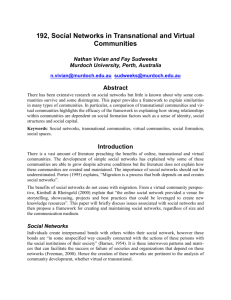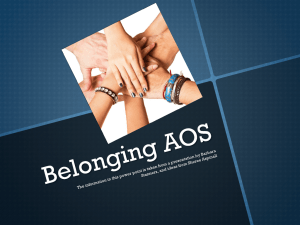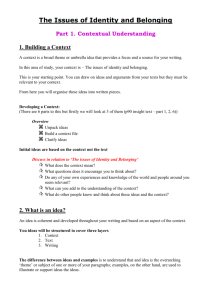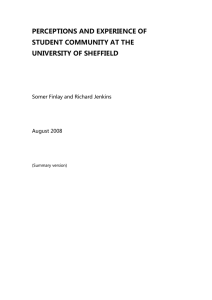Social networks depend on the process of creating relationships
advertisement
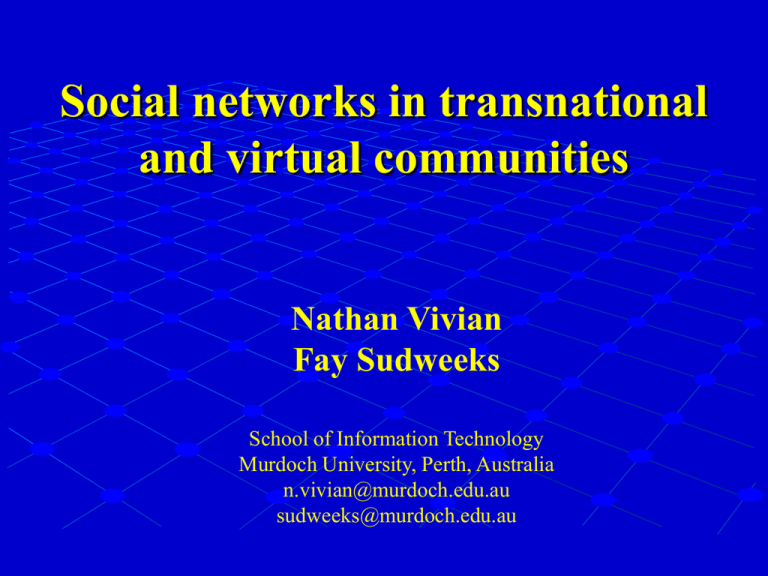
Social networks in transnational and virtual communities Nathan Vivian Fay Sudweeks School of Information Technology Murdoch University, Perth, Australia n.vivian@murdoch.edu.au sudweeks@murdoch.edu.au Question Why do some communities survive and some disintegrate? or more importantly … How are today’s communities created and maintained? Social Networks Social networks can explain how communities are created and maintained. Individuals create interpersonal bonds with others within their social network that are interwoven with the social institutions of their society. These interwoven patterns and matrices can facilitate the success or failure of societies and organisations that depend on these networks. Social Networks Social ties are not fixed. Networks are constantly being socially constructed and altered by their members. Interpersonal relations within social networks cut across traditional boundaries such as neighbourhood, workplace, kinship and class. Social Networks Sociologist in the 1950s anticipated disconnectedness, loss of community and weakly supportive relationships due to “rapid modernisation”. Yet the realisation of the Internet and modern technologies have provided for community creation well beyond expectation. Social Networks How have social networks facilitated communities? A proposed framework helps to explain how social networks facilitate the creation and maintenance of communities regardless of size and communication medium. In particular we look at transnational communities and virtual communities. Transnational Communities “Migration is a process that both depends on and creates social networks” (Portes, 1995) Transnational communities are characterised by perpetual back and forth border crossing movements among migrants. Communities whose mobility is celebrated as being “neither here nor there” (Portes) Communities whose mobility is a drama of displacement, destitution, and ultimate homelessness (Torres-Saillant) Virtual Communities • “The online social network provided a venue for storytelling, showcasing, projects and best practices that could be leveraged to create new knowledge resources” (Kimball & Rheingold, 2000) • People who are geographically separated or “on the road” need a way of maintaining contact, whether they are part of a large community or an organisational project team. • Virtual settlements. Basic Connections Relationships Social Spaces Identity/ Belonging Groups/Teams Key Members Social Structures Social Capital Social Formation Social Spaces Social spaces are: place-centered (embedded in particular location) trans-territorial (geographically disparate but intensely connected) and social spaces: are where individuals first meet and develop contacts provide the initial medium to form and maintain basic connections which enable individuals to create relationships create the identity or belongingness of the community (e.g. campus, shopping mall, town squares). Encourages the notion of belonging, especially in respect to a community Provides the initial medium and maintains … Basic Connections Can enable individuals to create … Meeting areas of common interest provide for … Social Spaces Communicate through the common medium Relationships Form/Change Groups/Teams Key members often control and utilise different forms of communication to maintain their networks, hence social capital Social spaces and places are new areas where people can meet, communicate with others and assimilate, providing the initial medium to form and maintain basic connections, which in turn enable individuals to create relationships. Members often have a feeling of belonging and therefore come back Effect of relational embeddedness Identity/ Belonging Strengthens Assist in forming strong bonds with members of the community Embedded community members affect … Key Members Social Structures A direct and sometimes transparent relationship Embedded community members mobilise … Social Formation Social Capital Social Formation Relationships exist between individuals or between groups which are mostly dynamic but strengthen a sense of identity and belonging in groups and teams. Notion of community consciousness These groups are often in different social arenas, but are identifiable in any community. The key members of these groups are those who are stakeholders within their community. Social Formation Key members use communication and social spaces to maintain their networks. Community members are embedded in the community in two ways: how they relate personally to each other (relational embeddedness) how social relationships affect social structures (structural embeddedness) Encourages the notion of belonging, especially in respect to a community Provides the initial medium and maintains … Basic Connections Can enable individuals to create … Meeting areas of common interest provide for … Social Spaces Relationships Communicate through the common medium Form/Change Groups/Teams Key members often control and utilise different forms of communications to maintain their networks, hence social capital Members often have a feeling of belonging and therefore come back Effect of relational embeddedness Identity/ Belonging Strengthens Assist in forming strong bonds with members of the community Embedded community members affect … Key Members Social Structures A direct and sometimes transparent relationship Social formation and social structures are dependent on the relationships of the community members. Embedded community members mobilise … Social Formation Social Capital Social Capital Social capital is defined as a player’s level of cooperativeness within a social network. A social network is a set of players and a pattern of exchange of information and/or goods among these players. Social capital is developed and maintained over time through regular communication, participation in events and membership of associations. Participation alone is not capital building – reciprocation is required. Encourages the notion of belonging, especially in respect to a community Provides the initial medium and maintains … Basic Connections Can enable individuals to create … Meeting areas of common interest provide for … Social Spaces Communicate through the common medium Relationships Form/Change Groups/Teams Key members often control and utilise different forms of communication to maintain their networks, hence social capital Members often have a feeling of belonging and therefore come back Effect of relational embeddedness Identity/ Belonging Strengthens Assist in forming strong bonds with members of the community Embedded community members affect … Key Members Social Structures A direct and sometimes transparent relationship The resources of any player is not the social capital, rather it is the individual’s ability to mobilise that capital on demand. Embedded community members mobilise … Social Formation Social Capital Encourages the notion of belonging, especially in respect to a community Provides the initial medium and maintains Basic Connections Can enable individuals to create Meeting areas of common interest provide for Social Spaces Relationships Communicate through the common medium Form/Change Groups/Teams Key members often control and utilise different forms of communications to maintain their networks, hence social capital Members often have a feeling of belonging and therefore come back Effect of relational embeddedness Identity/ Belonging Strengthens Assist in forming strong bonds with members of the community Embedded community members affect Key Members Social Structures A direct and sometimes transparent relationship Embedded community members mobilise Social Formation Social Capital Transnational Communities Not only individual people migrate, but their social networks migrate also. Social networks are crucial for finding jobs, accommodation, psychological support, social and economic information. Migration is a process of network building, which reinforces social relationships across space. Virtual Communities Virtual community members bring offline values and interactions in their online communities. Many believe that virtual communities are sociologically the same as their “brick and mortar” counterparts. Conclusions Social networks do not depend on one relationship or on any particular social space in which people meet. Social networks depend on the process of creating relationships, embedding oneself into the social structure – whether the structure be transterritorial or virtually co-located – and the ability to mobilise social capital. References Annen, K. (Forthcoming). Social Capital, Inclusive Networks, and Economic Performance. Journal of Economic Behavior & Organization. Barnes, J. (1954). Class and committees in a Norwegian island parish. Human Relations, 7, 39-58. Blanchard, A., & Horan, T. (1998). Virtual communities as social capital. Social Science Computer Review, 16, 293-307. Burt, R. (2000). The Network Structure of Social Capital. Research in Organizational Behaviour, 22(22), 345-423. Freeman, L. C. (2000). Visualising Social Networks. Journal of Social Structure, 1(1). Granovetter, M. (1985). Economic action and social structure: The problem of embeddedness. American Journal of Sociology, 94, 481-510. Kimball, L., & Rheingold, H. (2000). How online social networks benefits organizations. www.rheingold.com/Associates/onlinenetworks.html [retrieved 6 March 2003). Miller, D., & Slater, D. (2000). The Internet: An ethnographic approach. Oxford: Berg. Nohria, N., & Eccles, R. G. (1992). Networks and Organizations: Structure, Form, and Action. Boston: Harvard Business School Press. References Portes, A. (1995). The economic sociology of immigration. In A. Portes (Ed.), Economic Sociology and the Sociology of Immigration: A conceptual Overview (pp. 141). New York: Russell Sage Foundation. Portes, A. (1996). Global Villagers: The Rise of Transnational Communities. The American Prospect (25), 74-77. Sassen, S. (2000). New frontiers facing urban sociology at the millennium. British Journal of Sociology, 15(1), 143-159. Tarrow, S. (1998). Power in Movement: Social Movements and Contentious Politics. Cambridge: Cambridge University Press. Vertovec, S. (2001, June 30-July 1). Transnational social formations towards conceptual cross fertilization. Paper presented at Transnational Migration: Comparative Perspectives, Princeton University. Wellman, B., & Gulia, M. (1999). Net surfers don't ride alone: Virtual communities as communities. In B. Wellman (Ed.), Networks in the Global Village (pp. 331-367). Boulder, CO: Westview Press.
